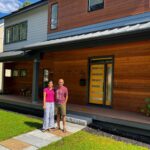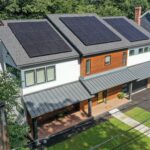 Did you always assume a house that could produce all its energy via solar and use no fossil fuels (and create no carbon emissions) was a nice idea but would have a prohibitive cost? That it would look unusual and not “fit” in the neighborhood? Well as you will see in our story below, this is not at all the case, especially when set as a goal from the beginning. These are referred to as Net Zero Energy (NZE) homes, and they are beginning to penetrate the market in new construction.
Did you always assume a house that could produce all its energy via solar and use no fossil fuels (and create no carbon emissions) was a nice idea but would have a prohibitive cost? That it would look unusual and not “fit” in the neighborhood? Well as you will see in our story below, this is not at all the case, especially when set as a goal from the beginning. These are referred to as Net Zero Energy (NZE) homes, and they are beginning to penetrate the market in new construction.
Smriti Rao and her husband Karthik Balasubramaniam were in the process of working with their architect to design a new 5,000-square-foot home in Needham. When they asked about the HVAC system for the house, they were told that it would be a traditional system with gas heat and AC. Wanting to explore new technologies to minimize carbon emissions, they turned to Green Needham’s “Ask the Expert” service, which offers free engineering and technical advice to homeowners trying to reduce the environmental impact of their new or existing homes.
Ed Quinlan, Green Needham’s energy coach, contacted Smriti and Karthik. He reviewed the architectural drawings and provided an analysis of various options for heating, cooling, and generating electricity from a solar PV system. The analysis included estimates of construction costs, energy consumption, and carbon emissions.
They decided to pursue the goal of achieving Net Zero Energy use (NZE). A NZE home generates enough solar power to provide 100% of the electricity consumed annually by the heating, cooling, and miscellaneous electrical systems. In order to accomplish this, the house heating system needs to be a heat pump, rather than a gas furnace. All other appliances need to be electric (induction electric cooktop, heat pump, water heater, etc.).
Smriti and Karthik reviewed their NZE goal with their architect and contractor. They had the option of using an Air Source Heat Pump (ASHP) or a Geothermal Heat Pump (GHP), both of which provide heating and cooling. For new construction, with State and Federal tax incentives and no need to install gas service/piping, the net cost of an ASHP system is less than or equal to the cost of a traditional gas heating system and AC. But they decided to opt for the GHP system, which is more costly but also the most efficient heating/cooling system available.
The entire HVAC system, including GHP sub-system, cost about $142,000. They received approximately $56,000 in State and Federal credits, reducing the net cost to $86,000. A traditional HVAC system with gas heat and conventional AC would have cost approximately $60,000. Thus, the net added cost of the GHP system vs. the conventional system was $26,000, which is less than 2% of the total construction cost and has the impressive benefit of reducing the operating costs to zero, as discussed below.
To power their new home, they installed a solar PV system on the roof. The solar system was sized for 100% of the annual electrical consumption. The 14 kW system cost $51,000 ($34,700 after Federal / State incentives) and will produce approximately 17,000 kWh/year. At the end of the day, the solar system should generate all the electricity the house needs, resulting in zero carbon emissions and zero energy bills. With no electric or gas bills, Smriti and Karthik will save approximately $4,800 a year in operating expenses as compared to the conventional system.
When asked what they would do differently if they had to do it over again, they both agreed that they should have incorporated the NZE goals early in the design process before the job had been awarded to a contractor. This would have streamlined the design process and possibly resulted in more competitive pricing — an important point to remember for others who are thinking of doing this in a new home project.
Net Zero Energy should be part of your plans when designing a new home. If you have any questions, reach out to us at “Ask the Expert.”
This is the first in a series of blog posts that will feature local examples of moving toward Net Zero Energy, both with new construction and with retrofits of existing homes.


